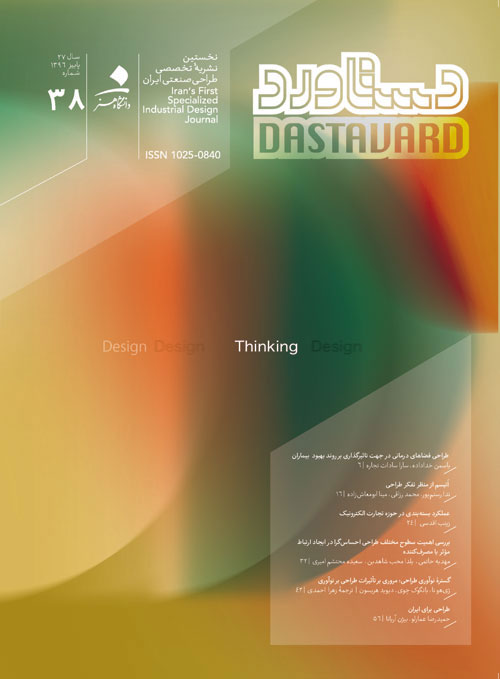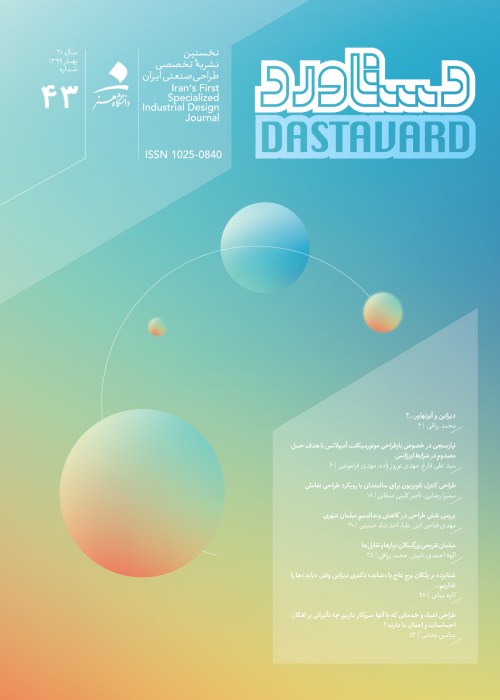فهرست مطالب

مجله دستاورد
پیاپی 38 (پاییز و زمستان 1396)
- تاریخ انتشار: 1397/01/07
- تعداد عناوین: 7
- سرمقاله
-
صفحات 4-5
- پژوهشی
-
صفحات 6-15بیماران در طی دوران درمان نه تنها ازلحاظ جسمی بلکه ازلحاظ روحی هم تحت فشار قرار دارند. متاسفانه کامل نبودن تسهیلات بیمارستانی گاهی رنج آن ها را دوچندان کرده، تا جایی که محیط بیمارستان را به محیطی کسالت بار تبدیل می کند؛ درنتیجه، بیمار گاهی حتی بدون توجه به نیازش به خدمات درمانی، دوست دارد هرچه زودتر محیط بیمارستان را ترک کند. این مطالعه با پرداختن به عوامل تاثیرگذار بر روحیه بیماران، سعی بر یافتن دستورالعمل هایی برای بهبود طراحی فضای داخلی بیمارستان و عناصر موجود در آن دارد. ازاین رو در این پژوهش ابتدا به مطالعه روش هایی که تحت عنوان طب مکمل از آن یاد می شود، پرداخته شد. سپس سه نمونه از بیمارستان های داخل کشور موردبررسی قرار گرفتند و با نمونه های کشورهای توسعه یافته مقایسه شدند. درنتیجه، مشاهده شد که در بعضی از کشورها از روش های طب مکمل برای بهینه سازی فضای درمانی استفاده می شود، درحالی که در بیمارستان های داخلی به این موضوع توجهی نشده است و جا دارد که به آن پرداخته شود. به همین منظور مطالعه ای انجام شد و پنجاه نفر کاربر شامل بیماران و کارکنان بیمارستان مورد مصاحبه قرار گرفتند. برای این ارزیابی از روش کانسی استفاده شد. به این ترتیب با جمع آوری کلمات و عبارات کانسی و پر کردن پرسش نامه های هفت مرحله ای، نظرات کاربران گردآوری شد. نتایج به دست آمده، بررسی و تجزیه-تحلیل شدند و فاکتورهای تاثیرگذار بر بیماران و کارکنان در محیط درمانی شناسایی شدند. بر همین اساس، مشخصه های طراحی محیط و وسایل موجود در آن تعیین شدند. این مشخصه ها می توانند برای طراحی محیط های درمانی مورداستفاده قرار گیرند تا محیطی تاثیرگذار برای بهبودی هرچه بیشتر بیماران ایجاد شود.کلیدواژگان: طراحی فضا، معیارهای طراحی، بهبود بیماری، طب مکمل
- مروری
-
صفحات 16-23این مقاله، مروری است بر معرفی اختلال اتیسم ، تاثیرات و چالش های اجتماعی عدم توجه و رسیدگی به این اختلال. همچنین در این مطالعه، درمان های چندبعدی و بینارشته ای این اختلال و همکاری طراحان و متخصصان روان شناس در خارج از کشور در مقابل روان شناسانه در داخل ایران مورد مقایسه قرار می گیرند. این مطالعه درمان های صرفا تیسم نه به شکل یک تلاشی است در باب استفاده از تفکر طراحی؛ فرایندی که طی آن، ا اختلال برای درمان، که به صورت یک امکان برای بهبود طراحی دیده می شود. این بررسی، با این جمع بندی که حضور فعالانه تخصص های متفاوت در کنار هم سبب مهیا کردن جامعه ای درخور نیازهای افراد مبتلا به اتیسم می شود، به پایان می رسد.کلیدواژگان: اتیسم، تعامل اجتماعی، جامعه، تفکر طراحی
- ترویجی
-
صفحات 24-30در این مقاله ترویجی، بسته بندی در فضای خرید اینترنتی و حضوری مقایسه شده است. رفتار خرید مخاطب در خرید اینترنتی متفاوت است؛ درحالی که بسته بندی همچنان براساس رفتار خرید حضوری طراحی می شود. در این مقاله، پروسه ای که بسته بندی براساس آن پیش می رود، در هر دو حالت بررسی شده و درنتیجه، تفاوت های المان های بسته بندی در دنیای مجازی با المان های بسته بندی در دنیای حقیقی که در فرایند طراحی باید به آن ها توجه کرد، بررسی شده است. به دنبال آن، تاثیرگذاری پارامتر زمان و فاکتورهای FMOT و ZMOT مقایسه شده است. همچنین فرصت ها و محدودیت های فضای مجازی برای بسته بندی عنوان شده و تجاربی مانند تجربه باز کردن در مرحله تحویل توضیح داده شده است. بررسی این تفاوت ها و دیدگاه ها می تواند بستری برای بازطراحی بسته بندی بسیاری از کسب وکارهای آنلاین باشد.کلیدواژگان: طراحی بسته بندی، تجارت الکترونیک، طراحی تجربه
-
صفحات 32-41از دغدغه های هر فرد طراح در هنگام طراحی محصول، آن است که چگونه می توان محصولی طراحی کرد که بتواند ارتباط عمیق و پیوند معنادار و قوی تری با طیف بیشتری از مردم برقرار کند. به عبارتی دیگر، این که لحاظ کردن چه مواردی در طراحی یک محصول می تواند تضمین قوی تری برای موفقیت آن کالا باشد، از نکات مهم و حیاتی در طراحی به شمار می رود. در این پژوهش که از نوع تحقیقات کیفی و توصیفی است و در آن از مطالعات اسنادی و بررسی مثال های کاربردی بهره گرفته شده ، سه سطح مختلف طراحیکلیدواژگان: طراحی محصول، طراحی احساس گرا، ارتباط احساسی
- ترجمه
-
صفحات 42-55در این مقاله، چهارچوبی برای درک، ارزیابی و اولویت بندی و بهبود تاثیرات طراحی بر نوآوری در شرکت های تولیدی معرفی می شود. ازآنجایی که بازسازی توان تولیدی شرکت ها، کلید رشد و ثبات اقتصادی متوازن آن ها، به ویژه در کشورهای پیشرفته است، آروین گرایانه، با بررسی ادبیات موضوعی گستره نوآوری طراحی، مصاحبه این پژوهش عمیق با یازده کارشناس در حوزه نوآوری طراحی و ساخت، جهت آشنایی با ارتباط موضوع شرکت تولیدی 45 مطالعه موردی نوآوری با تولید؛ هم در تئوری و هم در عمل، و نهایتا برای درک تاثیرات طراحی بر نوآوری آن ها انجام شده است. سطوح شناسایی شده از طراحی که بر نوآوری شرکت های تولید تاثیر می گذارند، عبارت بودند از: طراحی، استراتژی طراحی و تفکر طراحی که با پارامترهای نوآوری، ازجمله فناوری محصول/خدمات، فرایند و نوآوری سازمانی برای ایجاد گستره نوآوری طراحی هماهنگ شده بودند. این سطوح عملیاتی، زمینه تحقق توانمندی های نوآوری طراحی، برای تیم های پشتیبانی کننده داخل یا خارج شرکت را فراهم می آورد.کلیدواژگان: نوآوری طراحی، گستره نوآوری طراحی، نوآوری بهبودیافته و تولید
- جستار
-
صفحات 56-63مقاله پیش رو جستاری درباره راهکارهای طراحی برای ایران است؛ نظریات ارائه شده در این جستار بر مبنای تعاریفی مشخص از دو واژه طراحی بر بستر طراحی به معنای عام و ایران به مفهوم گستره مرزهای ایران فرهنگی یا ایران شهر است. درادامه و پس از مشخص نمودن این تعاریف، با بررسی و مقایسه نقاط ضعف و قوت رویکردهای موجود در رابطه با طراحی برای ایران؛ شامل طراحی عملیاتی، طراحی آرمان گرایانه، طراحی نوگرایانه بومی و طراحی اجتماعی- فناوری، پیشنهاد های مطرح شده در مقاله پیش رو برمبنای پذیرش مسئله عدم وجود یک رویکرد کارآمد طراحی در ایران ارائه شده است. درنهایت، راهکارهایی برای حل این مسئله ارائه می شود که شامل تلاش برای تدوین رویکرد ایرانی به فلسفه فناوری، نوگرایی در رویکردهای طراحی و نهادینه شدن نوآوری به ویژه نوآوری از جنس دگرگونی های بنیادی و تلاش برای ساخت ابزارها و روندهای نو طراحی است.کلیدواژگان: ایران، طراحی، فلسفه فناوری، نوآوری، روند طراحی
-
Pages 6-15Usually hospitals are dull and boring places, that patients do not like them. Therefore, not only the patients suffer physically, but they are also mentally under pressure and prefer to leave the hospital as soon as possible; although they still need treatments. This paper attempts to address affecting factors on the mental health of patients, to improve the design of hospital environment. For this aim, first, the traditional ways of treatment such as alternative medicine were studied. Then, three hospitals in Iran were investigated and compared within ones in developed countries. The results of this comparison showed that, in some countries, the hospitals were designed in a way to optimize the therapeutic space. However in the hospitals in Iran, these kinds of considerations were not observed. Therefore, a study was performed, and fifty people including patients, doctors and personnel of hospital were interviewed. The results were analyzed and the factors influencing therapeutic environment, for both patients and staff, were identified using Kansei methodology. Based on the achieved results, some design criteria for designing hospital environment, were identified. These criteria, would help designers to design more beneficial places for the patient in their recovery process in hospitals. The studies also showed an urgent demand of todays world for alternative medicine, along with modern medical processes.Keywords: Interior Design, Design Criteria, Progressive Healing, Alternative Medicine
-
Pages 16-23This article provides an introduction to autism disorder and its social impacts and consequences; if not treated properly. This paper also compares therapies, being practiced in Iran, using mere psychological treatments and overseas; utilizing multidimensional interdisciplinary therapies in which designers and psychologists go hand in hand to treat the disorder. This study postulates that Design Thinking can be regarded as an opportunity for the betterment of the disorder. Though, it is not just a technique for treating autism. It also hypothesizes that if different people with varied specialties, work actively together, they would facilitate community participation in a way that the needs and wants of people with autism are also responded suitably.Keywords: Autism, Social Interaction, Society, Design Thinking
-
Pages 24-30The purpose of this article is to compare Packaging in online shopping vs offline shopping. It is considered that, the customers behavior in online shopping is completely different from buying patterns in person; nevertheless the packaging is still mostly designed according to buying in person. In this article, the process in which the package is designed, is challenged; so the differences which are necessary for design process are to be considered. Following these parameters, the effect of time and 4 Moments of Truth)MOT(, including ZMOT, FMOT, SMOT and TMOT )Z,F,S and T stand for Zero, First, Second and Third respectively(are also investigated. Furthermore, the influence of the opportunities and limitations of ecommerce on packaging is also considered. This article suggests that the context of redesigning e-commerce packaging should be made by focusing on the discussed parameters.Keywords: E-Commerce, Packaging Design, Experience Design
-
Pages 32-41One of the of main concerns of designers in the process of product design is how to design a product which can make a deeper and more meaningful relationship with the broader range of consumers. In other words, one of the important and vital points in product design is to determine what are the elements to be considered to achieve to a more successful product. In this descriptive and qualitative research, three different levels of emotional design; Visceral Level, Behavioral Level, and Reflective Level, have been employed and their importance in relation to consumers have been studied. The results show that since each level of emotional design has a different influence on the consumer, applying all these three levels will lead up to a multilateral production success.Keywords: product design, emotional design, emotional relationship
-
Pages 42-55This paper discusses the expanding parameters of design and innovation, and constructs a design innovation spectrum a framework present ing a holistic overview of design influences on innovation, in order to comprehend, assess, and prioritise the areas of improvement to increase the innovativeness of manufacturing companies. The research con siders manufacturing industry because re-establishing manufacturing strength is a key agenda for balanced economic growth and stability, especially in advanced countries. This empirical research adopted a triangulation approach that included a literature review to construct a the oretical design innovation spectrum, which was then evaluated through in-depth interviews by eleven design innovation and manufacturing experts to link theories and practicality, and forty-six case studies of manufacturing companies to understand its practical implications. The identified design areas were designing, design strategy, and corpo rate-level design thinking, which were aligned with the parameters of innovation including technological, product/service, process, and or ganisational innovation to create a design innovation spectrum, which allows for overall assessment of design innovation capabilities, to be used by both internal and/or external design supporting teams to improve manufacturing companies innovativeness through design.Keywords: Design Innovation, Design Innovation Spectrum, Improving Innova tiveness, Manufacturing
-
Pages 56-63This article is an inquiry for finding new approaches towards design for Iran. The propositions are built upon two fundamental concepts; Design, in its general meaning, without any disciplinary boundaries, and Iran as a cultural concept originated in Iranshahr. We explored and evaluated the existing design approaches in Iran, including Operational Design, Idealistic Design, Local Modernist Design, and Socio-technical Design. So, there is no single efficient design approach in Iran, and thus, a significant approach is needed.We discussed three main propositions: An attempt to explain an Iranian approach to philosophy of technology, Innovation in design processes, and inventing novel design tools and processes.Keywords: Iran, Design, Philosophy of Technology, Innovation, Design Process


